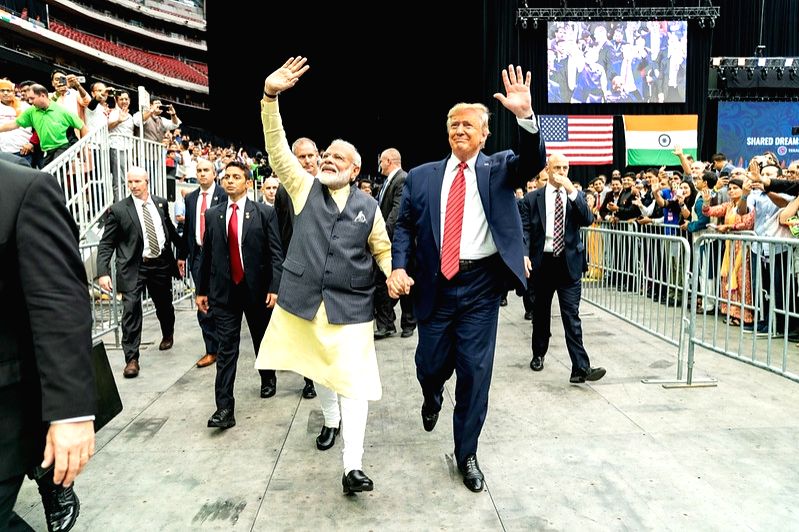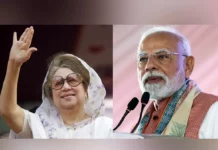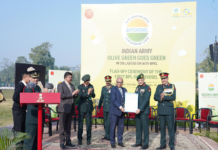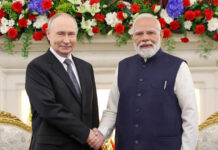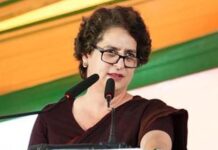NEW YORK: If the state of India-US ties in 2019 could be captured in an image, it would be that of Prime Minister Narendra Modi and President Donald Trump striding hand-in-hand before a cheering crowd of 50,000 people of Indian descent at the “Howdy Modi!” event in Houston in September.
The Acting Assistant Secretary of State Alice Wells, summed it up: “The trajectory of relations is on a steep upward climb… When you saw the President and Prime Minister Modi on the stage in Houston, it was really a celebration of what is best about our relationship.”
Modi declared at the event: “You can hear the heartbeat of this great partnership in this celebration of the world’s two largest democracies. You can feel the strength and depth of human bonds between our two great nations.”
Despite differences on trade and some other issues, the overall relations between the two democracies at the government and people-to-people levels reached a high point in 2012 undergirded by deepening cooperation in defence, counter-terrorism and diplomacy.
Trump concurred with Modi: “I’m happy to report that the relationship between the US and India is stronger than ever before.”
The New Delhi-Washington ties also weathered Trump’s quirky attempts at becoming an interlocutor between India and Pakistan on Kashmir, even claiming that Modi had asked him to be an arbitrator — an assertion dismissed by India — and his barbs on trade policies and climate change.
India was unflappable, choosing officially to ignore them. The core area of the intersection of interests is the Indo-Pacific, where Washington sees India as the counterweight to China’s rising power and New Delhi looks to extend its influence with its Act East policy while safeguarding its eastern maritime flank.
Emphasising it, a statement at the end of the 2+2 Strategic Dialogue this month of India’s External Affairs Minister S Jaishankar, Defence Minister Rajnath Singh and US Secretary of State Mike Pompeo and Defence Secretary Mark Esper said they “reaffirmed their commitment to work together in support of a free, open, and inclusive Indo-Pacific region”.
The concrete manifestation of the defence cooperation was in the three joint military exercises by the two countries and the defence equipment purchases. Besides the annual ‘Yudh Abhyas’ military exercise and a joint naval submarine-hunting exercise in the Indian Ocean, the two nations conducted their first tri-services exercise, titled the ‘Tiger Triumph’.
India made deals in 2019 to buy 13 MK 45 naval guns worth about $1 billion and 24 submarine-hunting MH-60R Seahawk helicopters valued at $2.6 billion. At the 2+2 meeting, the two countries signed the Defense Technology and Trade Initiative (DTTI) Industry Collaboration Forum agreement and the DTTI Standard Operating Procedure, which would permit closer cooperation.
They also agreed to expand the level of cooperation now seen in their navies to their armies and air forces. But looming behind the defence cooperation was India’s decision to buy the Russian S400 Triumf anti-missile system, which Washington has vehemently opposed and could bring sanctions against India.
That would be something to be resolved in 2020 while the US seeks to increase military sales to India, including jets to replace India’s ageing Air Force fleet. In July, the US Senate in its defence budget proposed expanding the Indo-Pacific defence cooperation with India to the Gulf region.
Widening their cooperation, the two countries signed an updated Science and Technology Agreement at the 2+2 meeting and agreed to work together in space, oceans and training of United Nations peacekeepers and to set up parliamentary exchanges. International terrorism, a consistent threat to both, was a topic on which India and the US stood shoulder-to-shoulder.
“We stand proudly in defence of liberty, and we are committed to protecting innocent civilians from the threat of radical Islamic terrorism,” Trump proclaimed in Houston. The US offered strong support to India when the Pakistan-based Jaish-e-Mohammad terror organisation attacked Indian security forces in Pulwama killing at least 40 personnel in February.
Washington condemned the attack and backed a UN Security Council condemnation of it.
Pompeo spoke directly to Pakistan Prime Minister Imran Khan about the terror emanating from that country, and when Indian Air Force Wing Commander Abninandan Varthaman was captured by Pakistan after his aircraft was shot down while an operation against terrorist camps, he helped arrange the pilot’s return to India.
The then-National Security Adviser John Bolton came out in open support of India’s self-defence against terrorist attacks. At the 2+2 meeting the ministers agreed to cooperate on forums like the Financial Action Task Force which combats terror financing as part of efforts to counteract cross-border terrorism.
Trade was the area with the most glaring and as yet intractable differences in 2019. Trump, who has been railing against India’s high tariffs, frequently citing the import duties on Harley Davidson motorcycles and whiskey, ended the General Scheme of Preferences for India, which gave some Indian exports preferential treatment.
At the end of the year, both countries were still struggling to resolve their trade differences widened by Modi’s Make in India and Trump’s America First policies. India’s requirement that the US financial companies store their data locally was one of the factors in the trade talks.
Holding up a trade deal are the US demand for access for dairy products and medical devices and India’s demands on steel and aluminium tariffs. But energy trade was on the rise in US favour, with India importing US oil and gas worth $7 billion in the last fiscal year and it is expected to go up to $10 billion in the current one. The tightening of oversight of H1-B visas for professionals and application rejections were another point of friction, although Indians continue to get more than 75 per cent of all visas in the category and there has been no noticeable fall in the number of the visas given to Indians.
India and the US have repeatedly emphasised their common democratic polities. “The ties between our two nations are grounded in our common values and our shared commitment to democracy,” Trump said in Houston, echoing Modi. But the openness of democracy was also the cause of friction, though not at the government level.
The House of Representatives Sub-committee on Asia held a hearing on ending of Kashmir’s special status, at which India was severely criticised. Several members of Congress like Indian-American Representative Pramila Jayapal have criticised Modi and his government over the Kashmir policy and issues like Citizenship Amendment Act and the National Register of Citizens and have introduced a House resolution on Kashmir. External Affairs Minister Jaishankar cancelled a meeting in Washington this month with House leaders because Jayapal was invited to the meeting.
The US Commission on International Religious Freedom also has criticised India over these issues and even demanded sanctions on Home Minister Amit Shah. India has lost the narrative on these matters, especially the citizenship laws, which is a measure to provide refuge to persecuted minorities from officially Islamic Pakistan and Afghanistan and Muslim majority Bangladesh.
India has not been able to get that message across and that protection would be extended to Christians for whom the Commission and others often express special concern showing that it was not a part of a narrow Hindu agenda as alleged.
The US media, which is tinged with anti-Hindu sentiments, has been at the forefront of the campaign against India with incomplete reporting. Lost on the lawmakers and the media with their tunnel vision of stereotypes is what a high-ranking State Department official said of US relations with India: “This is not a relationship where we deal in ultimatums. Again, I think this is a country, a democracy where these policies are being voted on, they’re being debated, they’re being reviewed by a judiciary.” IANS

